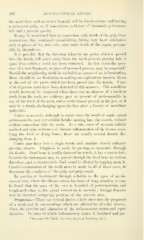Page 490 - My FlipBook
P. 490
;
488 DENTO-A L VEOLA R A BSCESS.
the nasal floor and an incisor beneath will be fonnd carious and havino;
a putrescent pulp, or, if non-carious, a history of traumatic pericemen-
titis and a present opacity.
It mav be mentioned here in connection with death of the pulp from
traumatism, that continued thread-biting, biting very hard substances
such as pieces of ice, nuts, etc., may cause death of the organ, presum-
ably by thrombosis.
It is possible that the direction taken by the probe Avhich is passed
into the fistula will j)oint away from the teeth present, passing into a
space from wdiicli a tooth has been extracted. In that event the pres-
ence of a root fragment, or ])iece of necrosed process, may be suspected.*
Should the neighboring teeth be excluded as causes of an inflammation,
there should be no hesitation in making an exploratory incision down
to the end of the probe which has been passed into the fistula. Cases
of dentigerous cysts have been detected in this manner. This condition
would, however, be suspected when there was an absence of a tooth or
teeth from the arch, no evidence past or present of pericementitis in
any of the teeth of the arch, and a cystic tumor present in the jaw, or it
may be a fistula discharging upon the face after a history of maxillary
periostitis.
Caries or necrosis, although in many cases the result of septic apical
pericementitis, may yet exhil)it fistula opening into the mouth, without
evident connection with the teeth. As a rule, cases of necrosis exhibit
marked and wide evidences of chronic inflammation of the tissues over-
lying the dead or dying bone ; there are usually several fistulae dis-
charging from it.
Caries may have but a single fistula and simulate closely ordinary
alveolar abscess. Diagnosis is made by passing an excavator through
the fistula. Dead bone is readily detected by touch, it has a rotten feel
in caries the instrument may be passed through the dead bone in various
directions, and a characteristic dead sound is elicited by tapping upon it.
Careful examination of the teeth must be made in all of these cases, to
determine the condition of the pulp and pulp canals.
In passing an instrument through a fistula to the apex of an ab-
scessed root, where the disease action has been of long duration, it may
be found that the apex of the root is denuded of pericementum, and
roughened—that is, the apical cementum is necrotic ; foreign deposits
may be detected occupying portions of the necrotic area.
Prognosis.—There are several factors which enter into the prognosis
of a tooth and its surroundings which are affected by alveolar abscess.
First, the severity and character of the inflammatory action and septic
invasion. In cases in which inflammatory action is localized and pre-
* See case—Dr. Black, American System of Dentistry, vol. i.
488 DENTO-A L VEOLA R A BSCESS.
the nasal floor and an incisor beneath will be fonnd carious and havino;
a putrescent pulp, or, if non-carious, a history of traumatic pericemen-
titis and a present opacity.
It mav be mentioned here in connection with death of the pulp from
traumatism, that continued thread-biting, biting very hard substances
such as pieces of ice, nuts, etc., may cause death of the organ, presum-
ably by thrombosis.
It is possible that the direction taken by the probe Avhich is passed
into the fistula will j)oint away from the teeth present, passing into a
space from wdiicli a tooth has been extracted. In that event the pres-
ence of a root fragment, or ])iece of necrosed process, may be suspected.*
Should the neighboring teeth be excluded as causes of an inflammation,
there should be no hesitation in making an exploratory incision down
to the end of the probe which has been passed into the fistula. Cases
of dentigerous cysts have been detected in this manner. This condition
would, however, be suspected when there was an absence of a tooth or
teeth from the arch, no evidence past or present of pericementitis in
any of the teeth of the arch, and a cystic tumor present in the jaw, or it
may be a fistula discharging upon the face after a history of maxillary
periostitis.
Caries or necrosis, although in many cases the result of septic apical
pericementitis, may yet exhil)it fistula opening into the mouth, without
evident connection with the teeth. As a rule, cases of necrosis exhibit
marked and wide evidences of chronic inflammation of the tissues over-
lying the dead or dying bone ; there are usually several fistulae dis-
charging from it.
Caries may have but a single fistula and simulate closely ordinary
alveolar abscess. Diagnosis is made by passing an excavator through
the fistula. Dead bone is readily detected by touch, it has a rotten feel
in caries the instrument may be passed through the dead bone in various
directions, and a characteristic dead sound is elicited by tapping upon it.
Careful examination of the teeth must be made in all of these cases, to
determine the condition of the pulp and pulp canals.
In passing an instrument through a fistula to the apex of an ab-
scessed root, where the disease action has been of long duration, it may
be found that the apex of the root is denuded of pericementum, and
roughened—that is, the apical cementum is necrotic ; foreign deposits
may be detected occupying portions of the necrotic area.
Prognosis.—There are several factors which enter into the prognosis
of a tooth and its surroundings which are affected by alveolar abscess.
First, the severity and character of the inflammatory action and septic
invasion. In cases in which inflammatory action is localized and pre-
* See case—Dr. Black, American System of Dentistry, vol. i.


